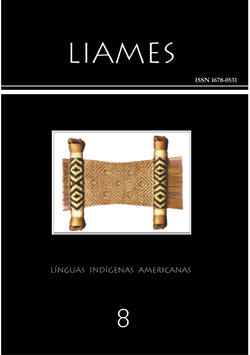Abstract
The modern Jivaroan languages and the reconstructed proto language have all been assigned a velar nasal phoneme /ŋ/ by previous analysts. In this paper I argue that such an analysis is incorrect, and propose that the velar nasals in surface forms come from two sources. The first is assimilation of an underlying unspecified syllable-final nasal archiphoneme /N/ to a following velar stop /k/. The second concerns a group of velar nasals that surface only in Aguaruna and arise as a syllable-final allophone of the phoneme /h/. I also propose to reconstruct a rhotic phoneme for the proto language rather than a velar nasal, and show that it has merged with /h/ in Aguaruna. Historical, comparative and documentary evidence is adduced to support these hypotheses.
References
ADELAAR, Willem F. H.; MUYSKEN, Pieter C. (eds.). (2004) The Languages of the Andes.Cambridge: Cambridge University Press.
Indeed, Aikhenvald & Dixon (2001: 4; and throughout) point out that the phenomenon of ‘parallel development’ should make us cautious of a proposed genetic relationship based on the reconstruction of a single innovation in a group of closely related dialects under conditions of geographical proximity and sustained contact.
AIKHENVALD, Alexandra Y. (1996) Words, pauses and boundaries: evidence from South American languages. Studies in Language 20: 487–517.
AIKHENVALD, Alexandra Y.; DIXON, R. M. W.(eds.) (2001) Introduction. In AIKHENVALD, Alexandra Y. Areal Diffusion and Genetic Inheritance: Problems in comparative linguistics, pp. 1–26. Oxford: Oxford University Press.
CORBERA MORI, Angel. (1994) Fonologia e Gramática do Aguaruna (Jívaro). Unpublished doctoral dissertation. State University of Campinas, Brazil.
DIXON, R. M. W. (2004) The Jarawara language of Southern Amazonia. New York: Oxford University Press.
FABRE, Alain. (2005) Diccionario etnolingüístico y guía bibliográfica de los pueblos indígenas sudamericanos [Updated version of Manual de las lenguas indígenas sudamericanas. Munich: Lincom Europa, 1998]. Accessed at: http://butler.cc.tut.fi/~fabre/BookInternetVersio/Alkusivu.html
FAST, Gerhard et al. (1996) Diccionario Achuar-Shiwiar Castellano. Lima: Instituto Lingüístico de Verano.
FOX, Anthony. (1995) Linguistic Reconstruction: An introduction to theory and method. Oxford: Oxford University Press.
GNERRE, Maurizio (1975) L’utilizzazione delle fonti documentarie dei secoli XVI e XVII per la storia linguistica Jíbaro. In E.Cerulli; Della G. Ragione (eds.). Atti del XL Congresso Internazionale degli americanisti vol. 3: 79-86. Genoa: Tilgher
GNERRE, Maurizio (1999) Profilo Descrittivo e Storico-comparativo di una Lingua Amazzonica: Lo Shuar (Jívaro). Naples: Istituto Universitario Orientale.
GORDON, Raymond G., Jr. (ed.). (2005) Ethnologue: Languages of the World, Fifteenth edition. Dallas, Texas: SIL International. Accessed at: http://www.ethnologue.com/
JAKWAY, Martha et al. (1987) Vocabulario Huambisa. Serie Lingüística Peruana 24. Lima: Instituto Lingüístico de Verano.
MATISOFF, James A. (1975) Rhinoglottophilia: The mysterious connection between nasality and glottality. In Charles A.Ferguson; Larry M. Hyman; John J. Ohala. (eds.). Nasálfest (papers from a symposium on nasals and nasalization), pp. 265-87. Stanford, California: Stanford University Press.
OVERALL, Simon E. (2007) A Grammar of Aguaruna. Ph.D. Dissertation. RCLT, La Trobe University, Australia.
PARKER, Steve. (1999) A sketch of Iñapari phonology. International Journal of American Linguistics 65: 1-39.
PAYNE, David L. (1978) Nasalidad en Aguaruna (Second edition). Serie Lingüística Peruana 15. Lima: Instituto Lingüístico de Verano.
PAYNE, David L. (1981) Bosquejo fonológico del Proto-Shuar-Candoshi: Evidencias para una relación genética. Revista del Museo Nacional 45: 323-377.
PAYNE, David L. (1990) Accent in Aguaruna. In Doris Payne (ed.) Amazonian Linguistics. Studies in Lowlan South American Languages, pp.161-184. Austin, TX.: University of Texas Press.
PELLIZARO, Siro; NÁWECH, Fausto Osvaldo (2005) Chicham: Diccionario Shuar Castellano. Quito: Abya-Yala.
PIKE, Kenneth L.; LARSON, Mildred L. (1964) Hyperphonemes and non-systematic features of Aguaruna phonemics. In Albert H. Marckwardt (ed.) Studies in languages and linguistics in honor of Charles C. Fries, pp. 55-67. Ann Arbor, Michigan: English Language Institute.
STARK, Louisa R. (1985) Indigenous languages of lowland Ecuador: History and current status In Harriet E. Manelis Klein; Louisa R. Stark (eds.) South American Indian languages: retrospect and prospect, pp. 157-193. Austin, TX: University of Texas Press.
TURNER, Glen D. (edited by Stephen H. Levinsohn). (1992) Una Breve Gramática del Shuar. Cuadernos Etnolingüísticos 19, Quito: Instituto Lingüístico de Verano.
WISE, M. R. (1999) Small language families and isolates in Peru. In R. M. W. Dixon; Alexandra Y. Aikhenvald (eds.) The Amazonian Languages, pp. 307-340. Cambridge: Cambridge University Press.
The LIAMES: Línguas Indígenas Americanas uses the Creative Commons license (CC), thus preserving the integrity of the articles in an open access environment.


